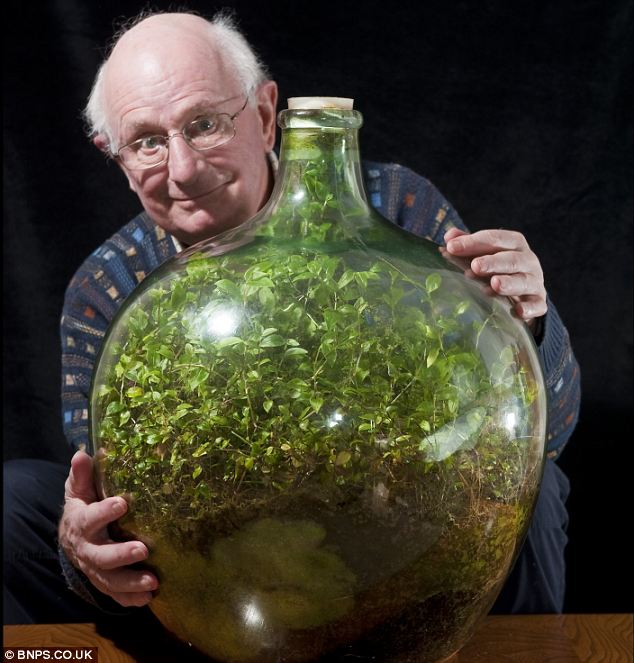Corn Cob Sprouting in Water
Description: This dramatic time lapse shows corn kernels sprouting over time. Each of the kernels represents a new corn plant and so corn cobs represent a wonderful organism for studying genetics. In elementary this phenomenon can be used to show what plants need to survive. In secondary students can investigate specific crosses, analyze patterns in the offspring, and could even study transposons "jumping genes".
Web Resources: Why Is Our Corn Changing? - Next Gen Storylines, Corn Genetics - Biology4Friends, Corn Genetics - Wikipedia
The Great Oxygenation Event
Description: The Great Oxygenation Event occurred when cyanobacteria living in the oceans started producing oxygen through photosynthesis. As oxygen built up in the atmosphere anaerobic bacteria were killed leading to the Earth's first mass extinction. The change in diversity and the arrival of appreciable atmospheric oxygen (as evidenced by the red bands in the rocks) can be analyzed to see what happens when a resource that was scarce becomes very abundant.
Web Resource: Great Oxygenation Event - Wikipedia
Why Do Sunflowers Follow the Sun?
Description: This is an excellent phenomenon that can be used in many different units. According to researchers only young sunflowers will follow the Sun. These flowers are following a natural circadian rhythm to receive the most light for photosynthesis. However when they mature the flowers will mainly face east. The reason for this is fairly simple, bees like warm flowers, and the flowers facing the east are the warmest.
Web Resources: The Mystery Of Why Sunflowers Turn To Follow The Sun — Solved - NPR, Helianthus - Wikipedia
Vegetable Oil as Fuel
Description: Vegetable oil can be used as fuel in both diesel cars and heating oil burners. Reclaimed vegetable oil that is used in food service industries could be used to reduce the amount of fossil fuels that are being used by humans. This phenomenon could be used in an energy unit related to either the physical or life sciences.
Web Resources: Vegetable Oil Fuel - Wikipedia, Students Power Bus with Vegetable Oil - NBC
Biosphere 2
Description: Biosphere 2 was created in the 1990's to model all the elements of Biosphere 1 (The Earth). Plants in the biosphere produced oxygen and food for the inhabitants. The carbon dioxide released during respiration was taken in by the plants cycling the matter with energy from the Sun. In this experiment oxygen levels steadily fell to dangerous levels and oxygen eventually had to be added to the biosphere. This large-scale phenomenon continues to be owned and run by the University of Arizona. The mystery of missing oxygen could be used as a phenomenon in a unit on matter cycling and energy flow. Students can even create biospheres of their own and monitor life over time.
Warning: This video contains strong language (11:06) and is not appropriate for younger viewers. Please use teacher discretion when showing segments of this video directly to children.
Web Resource: Biosphere 2 - Wikipedia
Algae Fuel and Food
Description: Algae food and fuel hope to reduce human dependence on fossil fuels and avert food shortages around the world. Algae fuel works in the same way as fossil fuels but the carbon dioxide released during combustion is carbon taken from the atmosphere in algae photosynthesis. Algae can also be used to create animal feed which currently uses large amounts of soil and water resources. This phenomenon can be use in an energy unit or life science unit related to mass and energy.
Web Resource: Algae Fuel - Wikipedia
Air Plants - No Soil Needed
Description: Air plants (Aerophytes) don't require soil to grow so they can use used as an introductory phenomenon as your students explore plant needs. Air plants live in areas with high humidity and are generally epiphytes (plants that live on but are not parasites of) living on larger trees. Air plants obtain the water they need to survive from the environment so they must either be misted or occasionally dipped in water.
Web Resource: Air Plant Care - HGTV, Air Plant Supply Co.
12 Years in a Sealed Ecosphere
Description: The Ecosphere in this video has been sealed in a glass container for 12 years. No air or food was able to enter or leave the Ecosphere during this entire time yet the shrimp are all still alive. This phenomenon can be used in the elementary science classroom to introduce plant and animal needs. It can be used in middle and high school to address matter cycling and energy flow.
Web Resources: Ecosphere (aquarium) on Wikipedia, Ecospheres
Ecosphere Sealed for Over 50 Years
Description: According to this Daily Mail article David Latimer has had a sealed ecosphere for over fifty years that he has only watered once.
Web Resource: Daily Mail article









